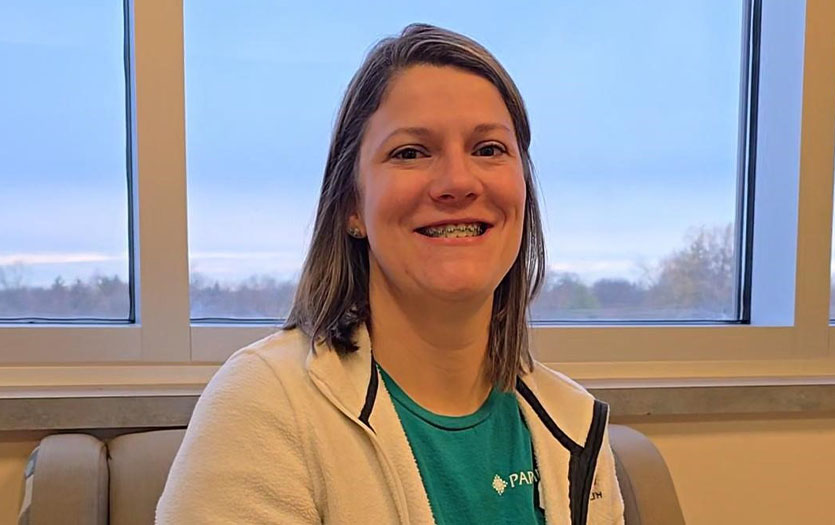
Enjoy this monthly mindfulness post from Dave Johnson, PhD, RN, LMFT, employee assistance specialist.
One of my favorite strategies when presenting mindfulness to company leaders or at conferences is the red car visualization exercise. I ask the group to pretend they’re looking out over a large parking lot, like Parkview Health’s, on a very busy day. I then instruct them to count just the red cars. After about 30 seconds, I ask them how many green cars were in the lot. Most folks look puzzled, some laugh and others venture a wild guess at the number of green cars. A few math wizards went so far as to develop a possible ratio of red to green. A few people drilled down and asked me if burgundy was red or if they could count trucks and vans.
The lesson here is that most of us wouldn’t have a clue about how many green cars were in the parking lot because our brains were focused on searching for the red ones. We simply “overlook” what we aren’t looking for. If we’re looking for faults, failures or “sins” in ourselves, others or systems (work, church, schools, families, etc.) we will certainly find them. Perhaps we will also miss other important aspects right in front of us. My frequent quip is that none of us are very pretty under a microscope and we need to be cautious about setting our intentions when looking for something.
Our brains are great search engines, and they will often help us find what we are looking for. I know as a nurse and behavioral scientist that the thinking brain works much better if you pose specific questions around the area that one desires knowledge or information. As a teacher, I love to cultivate critical thinking by asking good questions to jump-start the search engine process.
Mindfulness Based Stress Reduction (MBSR) practice engages the brain search engine with a specific intention to stay present in the current moment. Our intention is to come out of the thinking – and sometimes overthinking – brain and turn to sensory awareness (what we see, hear, touch, taste, smell and feel) in the present moment. It’s important to practice this noticing with an openness and nonjudgmental attitude. Practicing formally and informally cultivates awareness of the full spectrum of our colorful lives. With MBSR, we set our intention to pause and to notice.
Intentional pauses for coping with life change.
In my practice as a nurse therapist, I’ve noticed that often people’s perception of stress (mine as well) is connected with the past (what happened, should have happened, could have happened) or future worry about what might happen or is likely going to happen. None of us are immune to the velocity of change taking place in our lives and trauma of everyday living. Many good and blessed things leave us filled with gratitude, but bad things happen, too. Death, divorce, disease, loss of a job, aging, loneliness, etc. runs downhill and lands in all of our backyards. It’s not that thinking about the past and the future aren’t important to life and our ability to problem solve, but if that’s where we constantly live, we miss the now. And the now can be a bit of a respite to help us cope with our lives by taking us out of the thinking part of our brain. Not to mention that being present impacts our health and relationships.
Applying intention.
Consider these four examples of situations where MBSR can be helpful:
- Eating. Pause and ask yourself, “Am I hungry or am I stressed, angry, tired, lonely, confused, overwhelmed, etc.?” If hunger isn’t the issue, food is not a good solution. Setting an intention of noticing how stress impacts your eating and practicing mindful eating can have a dramatic impact on your health and well-being. Turning on awareness to what is nourishing food – how it looks, smells, tastes, temperature, texture, color – supports healthy behavior. Pausing to put your fork down between bites and intentionally chewing so you can actually taste each bite is a great place to start. (I will blog a bit more about this practice soon!)
- Relationships. Have you ever spoken to someone who really wasn’t listening or seemed to be distant or preoccupied? Setting an intention to pause and be present for those we care about promotes depth and connectivity. Notice, and I really mean notice, the eyes, emotion, voice and expression of those you communicate with. Be aware of your tendency to judge (yourself or others) and attempt to move your intention to curiosity, which is much more open. Attempt to use all senses (hearing, touch, taste, smell and feel) to intentionally stay present. We sometimes run into challenges when an emotional button is pushed during the conversation, which can trigger a rush of emotion (joy, sadness, anger, etc.). Riding the wave of emotion and staying present can be a challenge. For me, this is crucial with my wife, children and grandchildren. I often fail miserably. That is why I call MBSR a practice. And practice can be done formally and informally as well.
- Anger. Some of us have short fuses. We send an email we later regret. Words come out of our mouths that can never be taken back or completely forgiven. We soil our families, friends and communities sometimes with our intensity and reactivity. I recall my mother telling me when I was a child to take a slow deep breath and count to 10 when I go angry. She said this would help prevent me from doing things or saying things that I might later regret. And she was right. Slowing my breath, taking a mindful walk, and pausing from a heated discussion are all examples of using a bit of mindfulness to cope with anger and increase our emotional intelligence.
- Exercise. Most of us aspire to adopt a healthier fitness regime and lifestyle, but don’t have the time or make the time. Pause and reflect upon your current practices that promote vitality. Start your search engine of MBSR to notice your patterns of healthy and unhealthy practices in real time. Take yourself off autopilot breathing and notice your breathing during several moments during your stress-filled day. Journal, consult health experts, seek a mentor and engage your wellness awareness throughout your day.
Taking time for practice.
Practice can be very practical and informal, such as pausing in the examples above, or formal, as in an MBSR sitting meditation. I conduct these formal practice sessions at the Parkview Center for Healthy Living. Find a relaxing space and follow along now to begin your own practice or try this meditation* from a previous post:
Mindfulness-based stress reduction practice has been extensively researched and proven helpful for coping with changes, grief, healthy eating patterns, pain, anxiety, depression and many other chronic disease and autoimmune disorders. For more on stress management programs and techniques, contact the Parkview Center for Healthy Living at (260) 672-6500. Dr. Johnson also provides on-site guidance for teambuilding and transformational leadership, among other topics. To learn more about Employees Assistance Programs for your company, call Business Development at (260) 373-9013.
Other resources:
- For more on free 1:1 Stress and Mindfulness consultations (telephonic or in person), or free Stress Relief Mindful Meditation Practice sessions With Dr. Dave Johnson, call the Parkview Center for Healthy Living at (260) 672-6500.
- Watch Dr. Johnson’s TedX Fort Wayne talk on Integrate Mindfulness now on YouTube.
- Kabat-Zinn, J. (1990) Full Catastrophe Living. Delta Trade Paperbacks.
- Like Integrate Mindfulness on Facebook for more from Dr. Johnson.
*Dr. Johnson cautions anyone practicing this meditation to avoid doing so while driving or doing any other activity that requires your absolute concentration.



